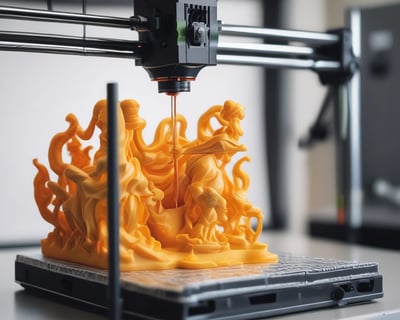Monsoon Offer!!! Get flat 15% off by using "RCMONSOON"
The Future of 3D Printing: Transforming the Art of Minimalist Sculptures
3D printing is revolutionizing the art and design industry, offering precision, customization, and sustainability. At Raw Curve, we use this cutting-edge technology to prototype and perfect our minimalist sculptures before mass production. With advancements in material science, AI-driven automation, and large-format printing, the future holds limitless possibilities for on-demand, eco-friendly, and intricately detailed sculptures. Explore how 3D printing is shaping the future of modern art in our latest blog!
TECHNOLOGY
Aditya Gaur
4/1/20252 min read
3D printing technology has revolutionized manufacturing, design, and art. What was once a niche tool for prototyping is now a major force shaping industries worldwide. For businesses like Raw Curve, which specialize in minimalist sculptures, 3D printing is not just a convenience but a game-changer. As this technology continues to evolve, its role in sculpture production, customization, and material innovation is set to expand dramatically.
The Growing Role of 3D Printing in Art & Design
In the past, sculptors relied on traditional methods such as clay modeling, carving, or mold-based casting to create their masterpieces. While these techniques are still valued, 3D printing introduces a level of precision, repeatability, and creativity that was previously unimaginable. Blender, a powerful 3D design software, allows us to create highly detailed models that are then brought to life using advanced printers like the Elegoo Neptune 4 Max.
This technology enables:
Rapid Prototyping: Artists can experiment with different forms and designs without the need for manual sculpting.
Intricate Detailing: The precision of 3D printing ensures even the most complex designs are accurately replicated.
Customization at Scale: Customers can request personalized sculptures, making each piece unique while maintaining production efficiency.
Sustainability & Material Advancements
As the demand for eco-friendly manufacturing grows, 3D printing is stepping up to the challenge. The use of resin, fly ash, and ceramic dust in our sculptures showcases how alternative materials can reduce waste and lower the carbon footprint of art production. Future advancements may bring biodegradable and recycled filaments, further enhancing sustainability.
With ongoing research in composite materials and hybrid 3D printing, we anticipate the ability to craft sculptures that mimic natural stone or metal textures while remaining lightweight and cost-effective.
Scaling Up Production with 3D Printing
Currently, 3D printing plays a vital role in our prototyping phase, allowing us to perfect our designs before moving to traditional molding techniques for bulk production. However, as large-format and high-speed 3D printing become more affordable, the possibility of direct-to-market 3D printed sculptures could soon become a reality. This would:
Reduce reliance on molds and manual processes
Enable on-demand production with zero inventory waste
Allow more intricate designs that traditional mold-based methods cannot achieve
The Future: AI & Automation in 3D Printing
AI-powered 3D printing is already on the horizon, allowing for self-optimizing prints that adjust layer thickness, infill density, and structural integrity in real-time. This will further streamline the art-to-product journey, reducing material waste while ensuring high-quality output.
Additionally, robotic arms and multi-material 3D printers could transform how sculptures are created, offering an even broader range of artistic possibilities.
Final Thoughts
For Raw Curve, 3D printing is more than just a tool—it’s the future of art production. As the technology advances, we envision a world where custom, high-quality minimalist sculptures are produced faster, more sustainably, and with unlimited creative potential.


RC Artistry
Crafting unique sculptures for your artistic space.
Design
Home Decor Experience
support@rawcurve.com
+91-8510919171
© 2025. All rights reserved.
